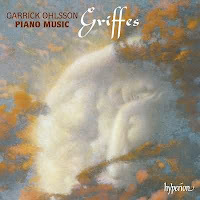Garrick Ohlsson, piano
Hyperion presents Charles Tomlinson Griffes’ sublime music played ravishingly by pianist Garrick Ohlsson. Chronicling the evolution of his decade-long career from an urbane cosmopolitan Impressionism to a style of supple abstraction cut short in 1920 by his death at thirty four, this recording is sure to rectify an inexplicable neglect of this early 20th century master through the astonishing efforts of Mr. Ohlsson.
Hyperion presents Charles Tomlinson Griffes’ sublime music played ravishingly by pianist Garrick Ohlsson. Chronicling the evolution of his decade-long career from an urbane cosmopolitan Impressionism to a style of supple abstraction cut short in 1920 by his death at thirty four, this recording is sure to rectify an inexplicable neglect of this early 20th century master through the astonishing efforts of Mr. Ohlsson.
More than his complete habitation of this music, the affinity of performer and composer is eerie – they share an overwhelmingly imaginative sensuality, rich and lush, without Debussy’s morbidity or Scriabin’s theosophy. The aural delights are tactile in these works so wonderfully written for the instrument. If Chopin is known as the ‘Poet of the Piano,’ can we call Griffes the ‘Painter of the Piano?’ Let’s stroll around the gallery.
“The Lake at Evening,” the first of the Three Tone Poems, Op. 5, is in a late romantic idiom, elegant in its formal simplicity. “The Vale of Dreams” brings to mind the surmise of scientists that some of the visual hallucinations produced by LSD are the brain ‘seeing’ its own folds. “The Night Winds,” all seeing and knowing, is phantasmagorical. Grander in scope are the Fantasy Pieces, Op. 6, of which the irrepressible exuberance of the “Barcarolle” balances the “Notturno’s” intimate caressing ardor; alas, the final Scherzo lacks the inspiration of the others.
”The White Peacock” that begins the Roman Sketches, Op. 7, is a thing unconsciously so in love with itself; it is a Narcissus that with consummate grace struts and fans. ”Nightfall” begins ominously, then rises to a splendid ecstatic climax. “The Fountain of Acqua Paolo” and “Clouds” if possible are more beautiful than the things they describe. (Is this not one of Art’s goals?)
From the same period, De Profundis (1915) reveals a philosophy of voluptuousness. The more astringent landscape of the Piano Sonata, compact and vigorous, leads to the terse 3 Preludes (1919), nearly atonal, by turns turbulent, unsettled, reaching towards a construction almost anguished on the cusp of the unknown . . .
Infinite colors spun with effortless naturalness, prismatic textures through light and shade from flickering gossamer to stentorian, an opalescent singing tone with a heavenly legato and a magical understanding of the pedals - all these place Garrick Ohlsson among artists of the first rank. With his penetrating intelligence and vast palette used to create superb evocations, he is a worthy successor to Gieseking. This is an album that will last.
-CrackCritic
-CrackCritic


No comments:
Post a Comment